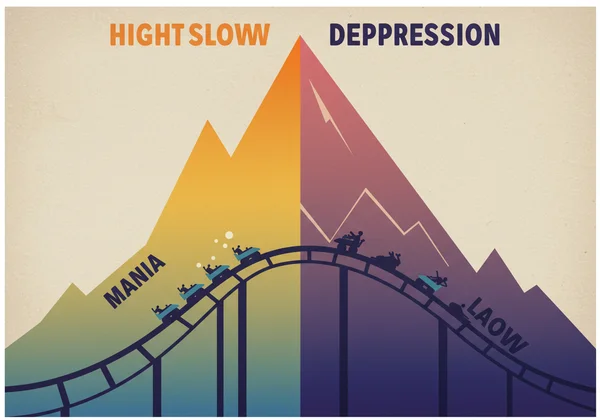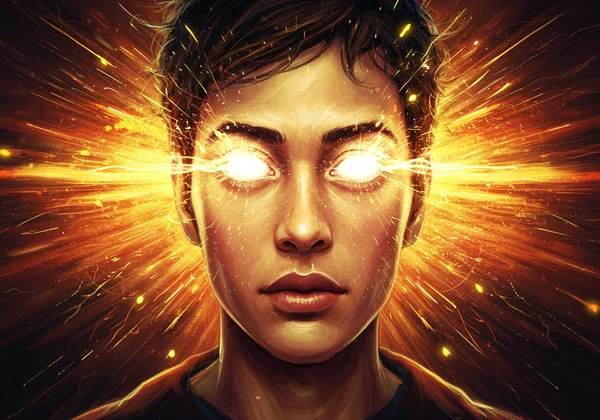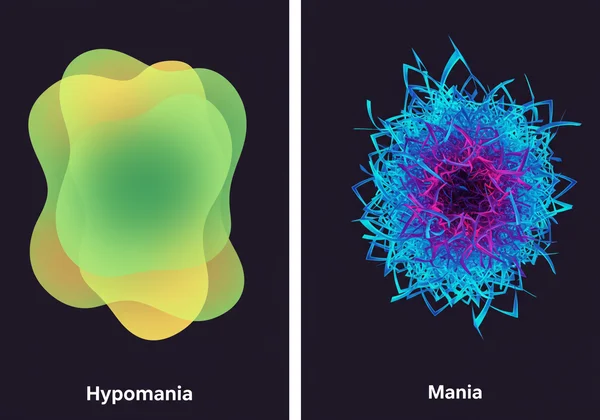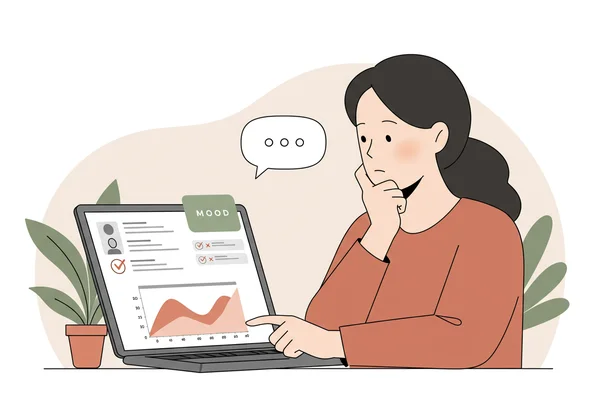Bipolar 1 vs. Bipolar 2 Test: Key Differences & Symptoms
Navigating the complex world of mood fluctuations can be confusing and isolating. You might feel like you're on a roller coaster, experiencing intense highs followed by crushing lows, leaving you to wonder what it all means. For many, this journey leads to questions about bipolar disorder and its different forms. If you've ever asked, "What is the difference between bipolar 1 and 2?", you're seeking clarity that is essential for understanding your experiences. This guide is here to illuminate those differences, helping you make sense of your symptoms. A crucial first step in this journey can be a confidential bipolar test to organize your thoughts before speaking with a professional. You can take our free bipolar test to gain preliminary insights today.

Bipolar 1 Disorder: Understanding Mania and its Impact
Bipolar I Disorder is often characterized by the presence of at least one manic episode. While many people with Bipolar I also experience depressive episodes, the defining feature that sets it apart from other mood disorders is the severity of the "highs." These manic episodes are significant mood disturbances that can profoundly impact a person's life, work, and relationships. They represent a distinct departure from a person's usual self.
Understanding the full spectrum of bipolar 1 symptoms is vital, as it involves more than just feeling good; it's a state of extreme energy and mood that can have serious consequences. This clarity is the first step toward seeking the right kind of support and understanding.
What Defines a Manic Episode in Bipolar 1?
A manic episode is not just a burst of energy or a happy mood. According to the diagnostic criteria outlined in the DSM-5, it is an intense period of elevated, expansive, or irritable mood and persistently increased activity or energy, lasting for at least one week and present most of the day, nearly every day. During this time, three or more of the following symptoms are significant:
- Inflated self-esteem or grandiosity.
- Decreased need for sleep (e.g., feeling rested after only three hours).
- More talkative than usual or pressure to keep talking.
- Flight of ideas or the subjective experience that thoughts are racing.
- Distractibility and inability to focus.
- Increase in goal-directed activity (socially, at work, or sexually) or psychomotor agitation.
- Excessive involvement in activities that have a high potential for painful consequences (e.g., engaging in unrestrained buying sprees, foolish business investments, or sexual indiscretions).
Crucially, the mood disturbance in a manic episode is severe enough to cause marked impairment in social or occupational functioning or to necessitate hospitalization to prevent harm to self or others.

The Often-Overlooked Depressive Episodes in Bipolar 1
While mania is the hallmark of Bipolar I, it's essential to recognize that major depressive episodes are also a common part of the mood cycle for many individuals. These depressive phases can be just as debilitating as the manic ones, presenting with symptoms like profound sadness, loss of interest in activities, fatigue, feelings of worthlessness, and suicidal thoughts.
The swing from an energetic, euphoric high to a deep, dark low is what defines the "polar" nature of the disorder. For some, these depressive episodes can last for weeks or months, often causing more cumulative distress over a lifetime than the manic episodes. An online bipolar assessment can help you track both highs and lows.
Bipolar 2 Disorder: The Role of Hypomania vs Mania
Bipolar II Disorder involves a pattern of depressive episodes and hypomanic episodes, but not the full-blown manic episodes that characterize Bipolar I. This is the single most important distinction between the two. Because hypomania is less severe than mania, Bipolar II can sometimes be misdiagnosed as major depression, especially if the person only seeks help during their lows.
Understanding the nuanced bipolar 2 symptoms is key for those who feel their experience doesn't quite fit the description of severe mania but is more than just moodiness. The central question often revolves around hypomania vs mania.
How Hypomania Differs from Mania (and Why it Matters)
A hypomanic episode shares many of the same symptoms as a manic episode—elevated mood, increased energy, and a decreased need for sleep. However, it is less severe and must last for at least four consecutive days. The key differences are:
-
Severity and Impairment: Hypomania is not severe enough to cause major impairment in social or occupational functioning. While friends and family may notice a change ("You seem so up!"), the person can typically continue with their daily responsibilities. Mania, by contrast, is severely impairing.
-
Hospitalization: Hypomania does not require hospitalization. A manic episode often does.
-
Psychotic Symptoms: Hypomania is not associated with psychotic symptoms like hallucinations or delusions. These can sometimes occur during a severe manic episode.

For many, hypomania can feel productive or enjoyable, leading them to not see it as a problem. However, it is an unstable state that is often followed by a crash into a depressive episode.
Understanding the Depressive Episodes in Bipolar 2
For individuals with Bipolar II, the depressive episodes are often the most prominent and distressing part of the illness. They experience one or more major depressive episodes, which can be long-lasting and severe. Because the hypomanic "highs" are less disruptive and may even be perceived positively, many individuals with Bipolar II only report their depressive symptoms to a doctor.
This is why it's so critical to recognize and report any periods of elevated mood and energy, no matter how mild they seem. A thorough screening, like an online bipolar disorder test, can prompt you to consider your full range of mood experiences, which is invaluable information for a healthcare provider.
Why Differentiating Bipolar 1 and 2 Matters for Your Journey
Distinguishing between Bipolar I and Bipolar II isn't just an academic exercise; it has real-world consequences for how you understand yourself and the path forward. Gaining this clarity can be a profound step toward wellness, validating your experiences and paving the way for effective management strategies. It empowers you to have more informed conversations and take an active role in your mental health journey.
Impact on Diagnosis and Treatment Approaches
An accurate diagnosis is the cornerstone of effective treatment. The management strategies for Bipolar I and Bipolar II can differ. For instance, the risk associated with manic episodes in Bipolar I may necessitate different medication approaches compared to Bipolar II, where the primary challenge is often managing recurrent and severe depression while preventing a switch into hypomania.
A professional diagnosis considers the full picture of your life, but your self-awareness is the starting point. Understanding these distinctions helps you provide a clearer history to a clinician, leading to a more accurate diagnosis and a personalized treatment plan that truly fits your needs.
The Role of Self-Assessment: Is There a Bipolar Test for Me?
So, is there a simple way to know for sure? While no online tool can provide a medical diagnosis, a well-designed self-assessment can be an incredibly valuable first step. It can help you organize your thoughts and identify patterns in your moods and behaviors that you may not have fully recognized.
If you're wondering whether your experiences align more with Bipolar I, Bipolar II, or another condition, a screening tool can provide a structured framework for exploration. Our free and confidential bipolar screening test, based on the Mood Disorder Questionnaire (MDQ), can help you explore your symptoms and provide you with instant insights.

Empowering Yourself with Knowledge: Your Next Steps
Armed with a clearer understanding of the nuanced distinctions between Bipolar I and Bipolar II—particularly the roles of mania versus hypomania—you're already on a powerful path toward greater self-awareness. This knowledge isn't meant to label you, but to serve as a vital tool in navigating your emotional landscape and preparing for informed conversations about your mental health. The most impactful next step is to leverage this insight productively.
This knowledge is not meant to label you but to empower you. It provides a language to describe your experiences and a framework to understand your emotional world. The most important next step is to use this knowledge productively. Taking a confidential online screening can be an excellent way to consolidate your observations before speaking with a professional.
Are you ready to take the first step toward clarity? Start your free test now to get instant, private insights into your mood patterns.
Frequently Asked Questions About Bipolar 1 & Bipolar 2
What is the difference between bipolar 1 and 2?
The main difference is the severity of the elevated mood episodes. Bipolar 1 Disorder is diagnosed after at least one manic episode, which is a severe mood disturbance that significantly impairs functioning and may require hospitalization. Bipolar 2 Disorder involves less severe hypomanic episodes and at least one major depressive episode.
How accurate is this Bipolar Disorder Test?
Our bipolar assessment test is a screening tool, not a diagnostic instrument. It is based on the widely used Mood Disorder Questionnaire (MDQ), which is aligned with DSM-5 criteria, to provide a reliable and informative first step. It helps identify patterns that may warrant further discussion with a qualified healthcare professional. For deeper understanding, our optional AI report offers personalized insights based on your answers. Taking our confidential screening test is a great way to prepare for that conversation.
What should I do after completing the Bipolar Disorder Test?
After receiving your instant results, we strongly encourage you to discuss them with a doctor or mental health professional. Your results, especially if you opt for the detailed AI report, can serve as an excellent starting point for a conversation. They can help you articulate your experiences clearly, leading to a more comprehensive evaluation and an appropriate action plan. Remember, this tool is here to guide you, not to diagnose you.
Disclaimer: This content is for informational purposes only and does not constitute medical advice. Please consult a qualified healthcare professional for any health concerns or before making any decisions related to your health or treatment.